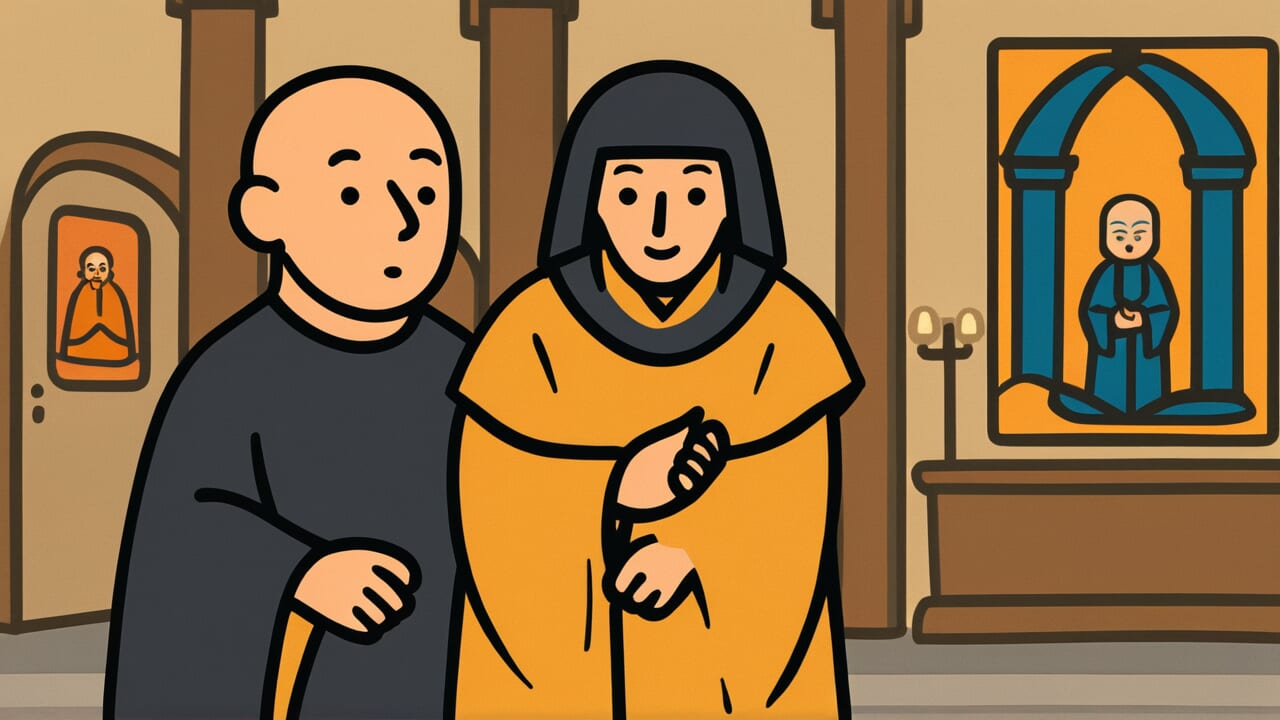How to Read “Bald in the back, horned wig in the front”
Ushirobōzu no mae kakukazura
Meaning of “Bald in the back, horned wig in the front”
“Bald in the back, horned wig in the front” describes a strange appearance where the back is bald like a monk while the front has a fancy horned wig.
This proverb points out when things or people’s words and actions lack consistency. It highlights contradictions and mismatches.
This saying is mainly used when someone’s words and actions lack consistency. For example, when what someone says is the opposite of what they do.
It also applies when the first and second half of a plan have completely different directions. Or when someone’s clothing or attitude lacks unity.
By showing how the back and front are extremely different, this proverb emphasizes more than just “contradiction.” It stresses how ridiculous and unnatural such inconsistency is.
Even today, this expression effectively criticizes people who act inconsistently or make arguments that don’t add up.
This proverb reflects Japanese aesthetics that value unity and harmony. It shows sharp observation skills.
Origin and Etymology
No clear written records remain about this proverb’s origin. However, we can make interesting observations from how the words are structured.
“Bōzu” refers to a monk’s shaved head. It means the back of the head is completely hairless.
“Kakukazura” (horned wig) was a type of hair ornament used by women in the Edo period. It was a decorative wig worn standing up like horns in the front hair area.
Courtesans and geisha especially used it to create a glamorous appearance.
In other words, this expression makes you imagine an impossible, strange appearance. The back is completely hairless like a monk, but only the front is decorated with a fancy horned wig.
This extreme contrast strongly emphasizes the lack of unity.
The popular theory is that it was born in Edo period common culture. It was used to mock contradictions and inconsistencies in appearance.
People of that time valued harmony and unity in appearance. Such an extremely mismatched look would have been a target of laughter and criticism.
While including elements of wordplay, it likely became established as an expression that sharply points out contradictions in people’s words and actions.
Usage Examples
- His management policy is bald in the back, horned wig in the front – he forces employees to save money while driving around in a luxury company car himself
- Advocating for environmental protection while producing tons of garbage is truly bald in the back, horned wig in the front
Universal Wisdom
The proverb “Bald in the back, horned wig in the front” shows sharp insight into human contradictions and inconsistencies.
Why was this proverb created and passed down through generations? Perhaps because humans are beings who naturally tend to carry contradictions.
We hold up ideals while compromising in reality. We are strict with others but lenient with ourselves.
We speak noble words but sometimes fail to act accordingly. Such contradictions are not unique to modern times.
They are universal human traits that transcend eras.
What’s interesting is that this proverb doesn’t just criticize. It includes humor.
By making us imagine the comical image of a bald back and horned wig front, it shows the tolerance to accept human contradictions with laughter.
Our ancestors understood how difficult it is to maintain perfect consistency.
At the same time, this proverb teaches the importance of unity and harmony. Everyone carries contradictions, but being aware of them matters.
It suggests that trying to match words and actions is the path to becoming a trustworthy person.
Accepting contradictions while aiming for consistency. This delicate balance might be the essence of being human.
When AI Hears This
The human brain has a tendency to automatically complete information it sees as a “complete whole picture.”
When we analyze the situation this proverb describes through cognitive science, surprising facts emerge.
The concept of viewpoint dependency shows that once humans recognize an object from one angle, they judge the whole based only on that partial information.
For example, if you see someone’s fine hairstyle from the front, your brain automatically assumes “this person is well-groomed in the back too.”
In other words, even if the back is actually bald, the brain creates a non-existent “complete image” based only on the front information.
This is the brain’s energy-saving strategy, but it also causes major misperceptions.
Even more interesting is the connection to the framing effect. The same person’s impression changes 180 degrees depending on which angle you show first.
Show from the front and they’re a “respectable person.” Show from the back and they’re “sloppy.” The order and scope of information presentation creates the perception itself.
Modern SNS profile photos and product advertisements always cut out and show only the “best angle.” This exploits exactly this cognitive trait.
Because the human brain has a habit of imagining the whole from parts, we must always be conscious that truth may be hidden in the parts we don’t see.
Lessons for Today
What this proverb teaches modern people is the importance of viewing yourself objectively.
We make judgments and choose actions in various situations daily. But is each one truly consistent?
Especially in modern society, opportunities to use multiple faces have increased. SNS posts versus real life, work attitude versus private behavior.
This isn’t bad in itself. But if you change even your fundamental values and beliefs depending on the situation, you lose trust from others.
You also lose sight of yourself.
What matters is regularly stopping to reflect on your words and actions. Do what you say and what you do match?
Is today’s judgment consistent with yesterday’s self? This habit of self-examination creates your axis as a person.
No one can maintain perfect consistency. But if you honestly acknowledge contradictions when you notice them and correct them, people will trust you.
A life with unity brings stability and confidence to your own heart as well.



Comments